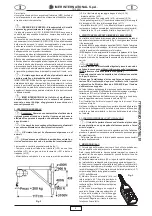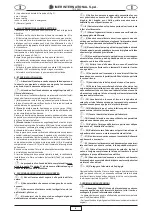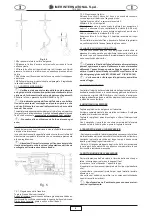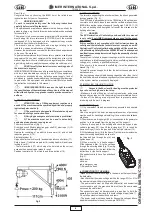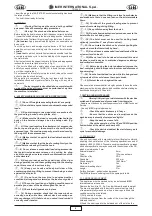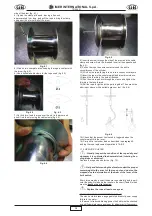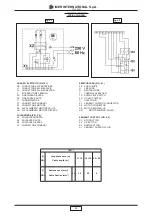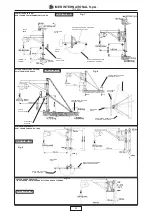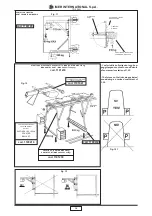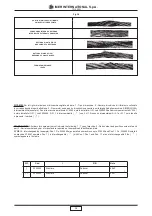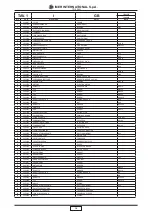
11
IMER INTERNATIONAL S.p.A.
TR 225 N
- CAUTION! Before working on the brake, ensure that
the load is removed, the electric power plug is disconnected
and the motor is cool.
Fig. 5
7.2.1. Braking adjustment
Remove cap 5 from fan cover 1.
Increased braking: turn locknut 6 gradually counter-clockwise and
check that the brake disengages in descent.
Decreased braking: turn locknut 6 clockwise.
7.2.2. Air gap adjustment
If the brake blocks or in the event of excessive wear, the air gap
should be adjusted as follows.
Remove fan cover 1 and disassemble fan 2.
Loosen the three hex screws 3.
Brake block: turn ringnut 4 clockwise to increase air gap 7 ad
release the brake, checking the gap distance (0.6-0.8 mm).
Brake wear: turn ringnut 4 counter-clockwise to reduce the air
gap, checking the gap distance (0.6-0.8 mm).
7LJKWHQWKHWKUHHKH[VFUHZVIXOO\GRZQDQGUH¿WWKHIDQDQG
fan cover.
To check brake grip, after adjustment, test braking several times
under full load.
7.3 GEARMOTOR LUBRICATION
The gearmotor unit must not develop oil leaks. Leaks may indicate
damage to the aluminium casing. In this case, reseal or replace
the casing.
- Check the gearmotor oil level through the sight glass
EHIRUHHYHU\VWDUWXS5H¿OODVUHTXLUHG7KHRLOVKRXOGEH
changed approximately every 2000 hours. Use gear oil with
ISO VG 460 viscosity at 40°C (SAE 90-140).
- Spent oil is classed as special waste and must be di-
sposed of in accordance with current applicable legislation.
7.4 ELECTRICAL SYSTEM
Check the condition of the insulating pendant control case. If it is
damaged replace it with an original IMER spare. Make sure that
the steel cable connecting the pendant control to the electrical
panel is shorter than the electrical cable to protect against pulling.
8. DISMANTLING THE HOIST
Remove all loads from the hook.
Wind the wire rope completely onto the drum. Disconnect the
power plug.
Remove the split pin from the support hinge and remove the
rotating frame.
If a trestle is being used, the carriage must be removed from
the hoist after it has been taken off the guides and before the
counterweight is removed.
9. TRANSPORT AND STORAGE
'RQRWOHDYHWKHLQVWDOOHGKRLVWXQDWWHQGHGZLWKRXW¿UVWGLVFRQ
-
necting the electric power supply and winding the rope completely
onto the drum.
When the machine is to be stored for a long period of time, make
sure that it is protected against atmospheric agents.
- During transport protect the machine from shock and crushing
which can adversely affect its functionality and mechanical strength.
10. SCRAPPING THE HOIST
To scrap the machine at the end of its service life, carry out the
following steps:
a) Drain out the oil by removing the oil plug.
b) Separate the various plastic and electrical components (cables,
pendant control, etc.).
c) Divide up the metal components according to the type of metal
(steel, aluminium, etc.).
After the various components have been separated, dispose of
them through authorised disposal centres.
- Dispose of properly. These components can cause
accidents and pollution.
11. TROUBLESHOOTING
FAULT
CAUSE
SOLUTION
'LI¿FXOWWR
lengthen the
telescopic arm
Emergency stop
button engaged
Turn to disengage
No power to
machine
Check mains
cable
Plug not inserted
Insert the plug
Power board
cutout tripped
Reset the overlo-
ad trip
'LI¿FXOWWR
lengthen the
telescopic arm
Lock knob too
tight
Slacken
The machines
lowers but does
not lift
Up limit switch is
faulty
Repair
IF THE FAULT PERSISTS
Contact IMER
technical service
12. PROCEDURE IN EVENT OF FAULT WITH LOAD
SUSPENDED
- If possible remove the load from the nearest level, then dismantle
and service the hoist.
- If this is not possible, use another lifting machine (with adequate
lifting capacity) from higher up and suspend the faulty hoist both
at the load and at the hoist attachment point.
/LIWWKHIDXOW\KRLVWVORZO\RIILWV¿WWLQJWKHQORZHUWKHHQWLUHDV
-
sembly to the ground.
- Do not attempt to turn the brake adjustment nut, as it would
become uncontrollable.
- Do not attempt to repair the fault on the machine with the load
suspended.
13. NOISE LEVEL AT THE OPERATOR’S EAR
The level Lp(A) given in the TECHNICAL DATA chart corresponds
to the weighted equivalent sound pressure level on scale A of
(XURSHDQ'LUHFWLYH(&7KLVOHYHOLVPHDVXUHGZLWKQR
load, at the operator’s head in the working position 1.5 metres away
from the instrument, considering the different working conditions.
Содержание TR 225 N
Страница 17: ...TR 225 N 17 IMER INTERNATIONAL S p A...



